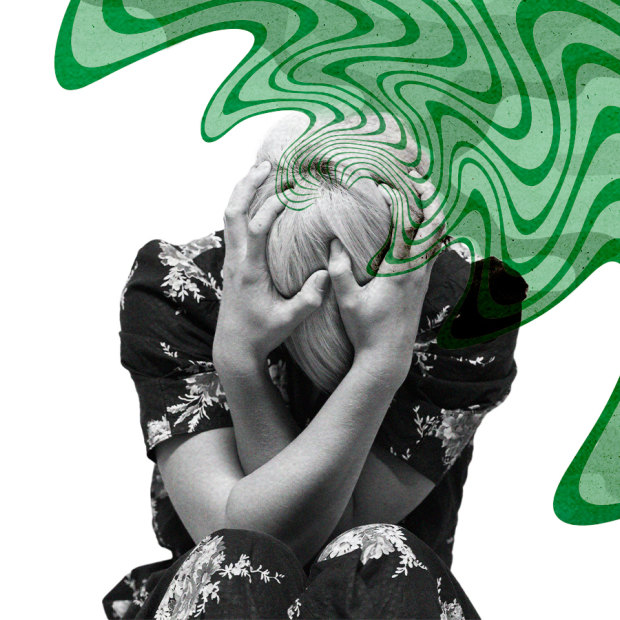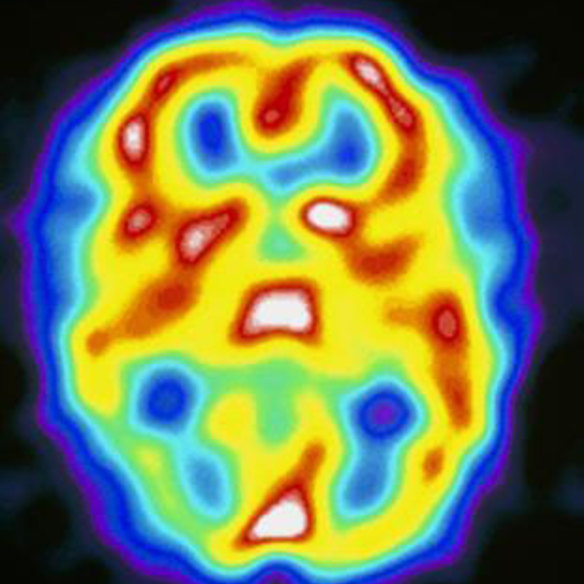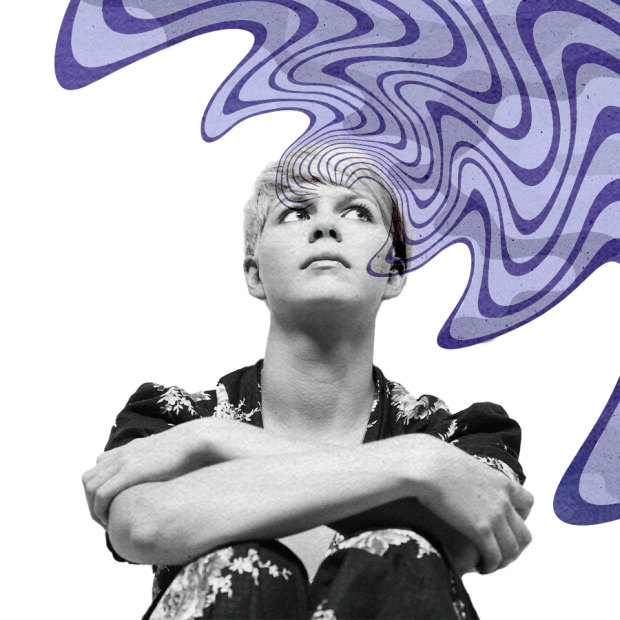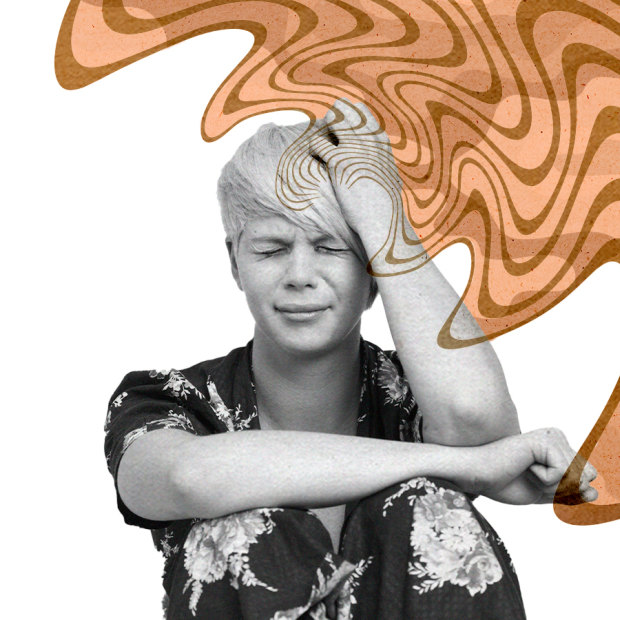Auras. Electric waves. Strange food cravings. For a condition that affects so many of us, migraine remains mysterious (and under-researched). Now a better wave of treatment is finally emerging.
When it happened – and I swear I’d only had one drink at the pub when it did – the first thing I noticed was that my date’s skin had turned green. In fact, everyone looked green; not seasick green, more bright alien green, as if they had all broken out the body paint – or shed their human camouflage – while I’d ducked into the loo.
But it wasn’t just the colours that were strange. My throat was raw, my ears buzzed. Everything suddenly had sharp edges, like sitting too close to a TV screen. The laughter of these green-skinned aliens became a roaring hurricane. I could taste my pulse. And then there was the ice pick of pain being driven through my skull, directly into my left eye.
It seemed the kind of thing worth mentioning to my date, but I could barely speak. This was the worst migraine I’d ever had. And it felt like a stroke (or what I thought a stroke would feel like). It certainly didn’t feel, as every migraine sufferer is loath to hear, like “just a headache”. But if you think I’m being dramatic, consider medieval times, when some found the pain of migraines so excruciating they let people drill into their skulls in search of relief.
Today, about 1 billion people suffer from this strange affliction, including 4.9 million Australians, and no two are quite the same. Migraines might strike a few times a year or multiple times a week, they might come with strange lights and green aliens, or vomiting spells. They might take away your vision altogether or the power of speech. They might throb with a world-ending pain or recede into a foggy “hangover”. “Some really can feel like a stroke and people will end up in emergency departments,” says neurologist and migraine expert Professor Richard Stark.
The World Health Organisation now lists migraine as the second-most disabling condition there is (after lower back pain), and the most common neurological disorder. Yet we still know very little about it. And only now are more promising treatments on the horizon.
What happens in the brain during a migraine? Why might some of us get them and not others? And how can you stave them off?
Credit:Artwork Aresna Villanueva
What are migraines?
We all get headaches, especially when we’re stressed or tired. But migraine is a disorder, an episode of which we call “having a migraine”. I usually feel one creeping up through my neck into my skull. When it hits full-strength, a migraine is like a headache in the way a roaring lion is like a newborn kitten. “It’s the feeling of having your brain scooped out with a rusty spoon,” says a friend and fellow “migraineur” as we swap war stories. That’s about right.
“There are headaches from things like caffeine withdrawal or drinking too much on a Friday night,” says Professor Lyn Griffiths, who led some of the world’s first research into the genetics of migraine in the ’90s. “But most people don’t understand migraine unless they get one.”
It’s not just the pain that’s worse. Migraines make the world too bright and too loud. You can become nauseous or dizzy. About 30 per cent of people get strange visual disturbances called “aura”, such as flashing lights or spots eating into your vision, like a cigarette burn on a film.
“Soon it was both eyes and, after about five minutes, I couldn’t see my notes, I couldn’t see at all.”
Sometimes, people can suffer disorientating bouts of “Alice in Wonderland syndrome”, where everything stretches out of proportion, either too big or too small. Author Lewis Carroll was himself a migraineur – along with a host of famous names in history from Julius Caesar to Thomas Jefferson. (Some believe that the swirling halos in Vincent van Gogh’s famous The Starry Night painting are really representations of his migraine auras.)
Griffiths recalls giving a lecture to hundreds of students when flashing lights started shooting across one of her eyes. “Soon it was both eyes and, after about five minutes, I couldn’t see my notes, I couldn’t see at all,” she says. “Luckily, I knew what I was talking about.”
Some people, meanwhile, lose the power to speak or, at least, to make sense when they do. In 2011, CBS reporter Serene Branson lapsed into gibberish during a live cross at the Grammys – what was first thought to be a stroke later became a migraine diagnosis.
Then, after the pain recedes, there’s often the “migraine hangover” – leaving people washed out and foggy for hours or even days.
“Everyone gets migraine differently,” says Griffiths, whose own have become much less frequent and less painful as she’s gotten older. “And, really, I don’t think any two migraines are quite the same either.”
Ulysses Grant (seated right) suffered a migraine the day Confederate general Robert Lee (seated left) signed the surrender at Appomattox Courthouse in April 1865, effectively ending the American Civil War.Credit:Emmanuel Degrand
It’s perhaps not surprising then, Stark says, that they remain under-diagnosed. Generally, if you have a bad headache lasting from between four and 72 hours without treatment, it’s a migraine. (“Migraines can build fast,” Stark says, but cautions “a headache that develops in an instant, like the snap of your fingers, is a red flag of something else”.)
Genetics researcher Dr Brittany Mitchell, who has found links between brain structure and migraine, once dismissed her own attacks as headaches. “Until my late 20s, I thought the wiggly lines I’d see [the aura] were from staring at the computer.” Then they intensified. “The pain was always in one specific part of my head, so I was worried it could be a brain tumour or something.” (Migraine pain is usually, but not always, in one side of the head. The word comes from the Greek for “half skull”.)
While migraine doesn’t change your life expectancy directly, it does often increase your risk of stroke and heart conditions. A rare severe form, familial hemiplegic migraine (FHM), causes people to lose feeling or strength down one side of their body, for example, and occasionally also leads to comas, seizures, or cerebral edema (a fluid build-up in the brain), which can be fatal.
Most migraine is debilitating, adds Mitchell, who describes days “out of action” when a bad one hits. In Australia, it is estimated to cost the economy $36 billion a year in healthcare and lost productivity. “People say ‘take a Panadol’,” Mitchell sighs. Sometimes, you can’t do anything but lie in a dark room. (In one of my own infamous attempts to push through a migraine while covering the Australian Open, I was found hugging a pot plant in a dark corner of the press trailer and had to be carried to the medical tent by a kind security guard.)
Yet, despite its impact, despite how common it is, experts agree migraine remains one of the most under-researched conditions around. “It’s still not taken seriously,” says Griffiths, who once analysed research grants in Australia and found only ear infections received less funding than migraine.
A brain scan taken during a migraine attack.Credit:Emory University
What is happening in the brain during a migraine?
Pain signals in overdrive. An electric wave sweeping through the brain. Dilated, even leaky blood vessels. There’s a lot going on in your head during a migraine. “When someone gets a heart attack, it’s pretty straightforward,” says Stark. “They get a narrow artery and the heart gets into trouble. But migraine is so complex. We still don’t understand all of what’s going on.”
It was once the wisdom of the day that “vapours rising from the stomach” caused migraines. Vomiting seemed to help, ancient Roman doctors enthused. Then, in the 1930s a chemical that constricted blood vessels was shown to offer relief, supporting the theory migraines are caused by bloodflow disturbances in the brain.
Today, scientists know blood vessels do dilate during migraine, which explains why the headache will often throb, but the main show is the nerve storm, says Stark. “Everything becomes more sensitised” as nerve fibres on the surface of the brain release chemicals that stir up pain signals. Some of those chemicals can also cause inflammation (and likely blood vessel dilation.) And then there’s the “electric wave” that often passes through the brain – known as spreading depression – when neurons suddenly switch their charge from positive to negative en masse, shutting down parts of the brain.
When neurons do this all at once, it’s a surge that can change brain cells and blood vessels. Scientists aren’t sure what triggers it. It’s almost like epilepsy, when parts of the brain fire up in a rush of activity – only in reverse, says Stark. But it explains the migraine aura some people get and, even in some cases, tingling or weakness down their arm. “Though people without aura can get this wave too, to some degree,” says Stark. And sometimes, people in later life (including Stark himself) will have this electric disturbance, and so aura, but without the headache.
Credit:
Who gets migraines and when?
“Migraine generally emerges in early life”, particularly during adolescence, says Stark. But there’s usually someone around to sympathise – roughly 90 per cent of migraineurs are related to someone with it. Take Griffiths’ family, for example. Not only did her mother suffer debilitating migraines, the kind that landed her sporadically in hospital, but both her son and daughter do, too. “And I only have two kids so that’s bad luck, isn’t it?” says Griffiths. “My son started getting them when he was five.”
Before puberty, it’s a fairly even split between the genders. Then things shift – about twice as many women have migraine as men, suggesting hormones play a role in the condition, too. “In any year, there’s about 20 per cent of women and 6 per cent of men suffering from migraine,” says Stark. “But if you look over their lifetime, you’re getting closer to 50 per cent for women [at some point].“
That’s because the frequency or severity of migraines often fluctuates throughout your life – Griffiths recalls how her son’s migraines were much more intense in childhood while her daughter’s emerged in adolescence and continued into adulthood. In women, migraines can flare up for the first time as menopause hits, or disappear entirely. “But it’s generally worse during childbearing years,” says Stark.
“It’s almost as though there’s a migraine circuit in all of us,” Stark says, one more easily tripped in some than others.
And it might not just be hormones at play. Women also have different brain structure to men, says Mitchell, and her research has so far linked smaller brain size, including in regions of the brain involved in sensory processing, to increased migraine risk. Of course, size isn’t everything for brains. “It doesn’t mean less activity,” she says. But these subtle differences in structure could affect both neuro-signalling and blood flow.
Migraines can also emerge for the first time after injury. “It’s almost as though there’s a migraine circuit in all of us,” Stark says, one more easily tripped in some than others. People with migraine, then, can be thought of as having extra-sensitive brains. If you test them in the lab, they’ll often show a stronger response to stimuli, he says, including colour contrast, loud noise and balance.
Indeed, most migraineurs can list their own personal triggers that seem to bring on an attack – from stress and sleep deprivation to storms, red wine, perfume, even cheese or chocolate.
Some can also sense when a migraine is coming on. They might get a stiff neck, like me, or strange food cravings or feelings of euphoria, even deja vu. They might be yawning a lot or thirstier than usual – all symptoms linked to dopamine levels in the brain, which are known to fluctuate before a migraine, Stark says. Sometimes what seems like a trigger could actually be a sign a migraine is already there. “Some people in the 24 hours before one will crave sweet things. So they regard chocolate as their trigger, but it could be that the migraine really triggered them eating the chocolate.”
Credit:
Why are migraines so common? What are migraine genes?
Why migraine remains so stubbornly common is itself a mystery. “You’d have thought being knocked out by headaches all the time would be a survival disadvantage,” says Stark.
Perhaps the heightened sensitivity of a sufferer is also an advantage. Could those of us with migraine be like the meerkats of the human world, alert to danger? “Yes, they make good sentries,” laughs Stark.
Griffiths thinks of it like this: “Back in caveman days, supposing there’s a storm coming, a drop in barometric pressure that triggers migraine [in] someone sensitive to their environment. They’ll go and find a nice dark cave to ride it out while everyone still outside is taken away by the flood or the storm or whatever.”
When the COVID pandemic hit, doctors noticed people with migraine seemed to have a slightly higher chance of catching the virus but greater survival odds when they did.
But the pain of migraine may be an unfortunate side effect of something even more crucial happening in the brain, says Stark. When the COVID-19 pandemic hit, doctors noticed people with migraine seemed to have a slightly higher chance of catching the virus but greater survival odds when they did. “So there’s a suggestion that some of the migraine genes might overlap with those that help you survive particular viral illnesses,” says Stark. Even inflammation itself, which emerges with migraine, can be painful, he says, but it also helps you get rid of viruses faster.
Griffiths, who heads the Centre for Genomics and Personalised Health at Queensland University of Technology, is examining how migraine is passed down through families – including sequencing the genomes of the isolated population of Norfolk Island (descendants of the Bounty mutineers). Some genes that directly cause rarer forms of migraine control the flow of chemicals in the brain. For more common migraine, it’s less clear-cut. “A lot of genes are implicated”, involving blood vessels, neurotransmitters, hormones and more. That suggests to Griffiths that everyone’s migraine storm could be a little different – and so is the fix.
How do you treat migraine?
Spare a thought for the migraineurs of our past. In the long history of failed treatment, not only is there grisly evidence of Stone Age neurosurgery to remove parts of the skull, but one medieval doctor preferred applying a hot iron directly to the site of pain in the head – or inserting garlic into a cut in the temple. The ancient Egyptians may have had a little more luck. When they tightly strapped clay crocodiles to sufferers’ skulls as an offering to the gods, they may have also been slightly compressing the head (and blood vessels within).
Today, along with anti-inflammatories or high-strength painkillers, one of the most common treatments for migraine are triptans: drugs used since the ’90s to constrict blood vessels in the brain and interrupt some irritant chemical signalling. A chemical now of particular interest is CGRP (calcitonin gene-related peptide). “That little bit of protein [involved in pain transmission] seems very important in triggering migraines, at least for many people,” says Stark. “And triptans might help disrupt it too, which could be why they’re so helpful.”
Of course, most drugs that stop a migraine must be taken early, at the first sign. As writer Joan Didion once noted, when an attack is under way, “no drug touches it”.
But when migraines come back again and again, a “rhythm” starts to build. “There’s almost a tipping point when you get about 15 headache days or more a month,” says Stark. People in that category have what’s called “chronic migraine”. The drugs that stop attacks can start to feed them instead, triggering one with any dip in the levels of the drug their body has become used to. So people with frequent attacks tend to be prescribed daily preventive drugs instead.
But the real breakthroughs have been only recent. First, Botox injections to the head, which are thought to stop the release of certain neural chemicals. And then monoclonal antibodies custom-designed to block CGRP. Both treatments are effective but expensive (though have at last been added to Australia’s Pharmaceutical Benefits Scheme for those with chronic cases).
There’s no silver bullet. A treatment that can transform one migraineur’s life will do nothing for another.
Indirect remedies can help, too, from caffeine (which constricts blood vessels) to magnesium supplements. But, there’s no silver bullet. A treatment that can transform one migraineur’s life will do nothing for another. Many will need to see a neurologist. Griffiths wants treatment personalised using genetics.
Of course, as well as the under-funding of research, experts say the enduring stigma of migraine as “just a headache” still stops people from getting treatment. “People will say, ‘my mum has migraine but I don’t, I just have these headaches …’” says Griffiths.
In one of those strange coincidences as I write this, puzzling why I alone in my family seem unlucky enough to suffer migraines, my mum calls. She’s just been diagnosed with migraine, ending the decades-long mystery of dazzling auras and occasional headaches she always put down to a long-standing but separate eye condition. (In fact, she now recalls her own mother lying in bed with the curtains drawn and a throbbing head on and off – which doctors of the day dismissed as “menopause”.)
“Migraine needs more attention,” says Stark. “In the past, there wasn’t a lot you could do, so people would just suffer in silence. But we have some effective treatments now, and more are coming … including different things targeting CGRP and other neurochemicals.”
He recalls a patient returning years after treatment to show him her PhD certificate. “She said: ‘There’s no way I would’ve been able to get this without it’.”
I can sympathise. That migraine may have caught me (and my date) off guard at the university pub that night, forcing me to seek refuge in a friend’s dark dorm, but today when I take my medication early, I can usually stop one in its tracks. (And I haven’t been carried out of a newsroom again.)
Stark says: “It’s one of the few conditions that people really do come in and go, ‘Doctor, you’ve changed my life’.”
Sign up for our Explainer newsletter – enlightening explanations for the world’s complex issues, delivered to your inbox every Sunday night.
If you'd like some expert background on an issue or a news event, drop us a line at [email protected] or [email protected]. Read more explainers here.
Most Viewed in Lifestyle
Source: Read Full Article





